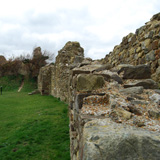History
In September of 1066, William the Conqueror landed at Pevensey and ordered the construction of a prefabricated wooden castle. Thereafter, he moved to Hastings and erected another wooden castle. William secured the Sussex coastline before departing to ultimately acquire the English crown from Harold II at the Battle of Hastings on October 14th, 1066.

Hastings Castle started as a wooden tower built atop a man-made mound or motte, surrounded by an outer courtyard or bailey. A wooden palisade enclosed the bailey. Following the conquest, the Norman motte and bailey castle would become a standard fixture across England. William, who planned ahead, took several wooden castles, prefabricated in Normandy, with him to England. After the Battle of Hastings victory, William ordered Hastings Castle rebuilt with stone. He passed the castle to one of his commanders, Humphrey de Tilleul. Upon Humphrey's return to Normandy, the castle was granted to Robert, Count of Eu. The count required 60 knights to serve the crown in exchange for the castle, town, and surrounding lands.
During the 1170s, the keep was rebuilt in the southeastern corner of the castle since the motte could not support it. Additional building improvements occurred during the reign of Henry II. Normandy was lost to the French during King John's reign. Fearing an invasion, King John ordered the dismantling of all Sussex castles to ensure they would not fall into enemy hands. Hastings Castle was refortified in the 1220s, with additional building renovations occurring in 1249. A quarter of a century later, in 1274, King Edward I issued naval ordinances from the castle. Just a few years later, in February of 1287, the cliff beneath the castle's south wall collapsed when violent storms battered the south coast of England, causing the wall and keep to fall into the English Channel.
In 1337 and 1339, the French attacked Hastings Castle, which eventually fell into disrepair and became ruinous.
Thomas Pelham purchased Hastings Castle on June 23rd, 1591, and used the site primarily for farming over the next few centuries. In 1824, the castle was excavated, with large portions of it undergoing reconstruction, including the chapel floor and parts of the chancel arch and walls. In the 1870s, the castle's dungeons were rediscovered near the north gate.
Hastings Castle received more damage during World War II when it was a target for bombing raids. In 1951, The castle was purchased by the Hastings Corporation and opened to the public as a tourist destination.
Castle Highlights
Hastings Castle resides high atop a cliff overlooking the old town of Hastings and the English Channel. You can reach it by driving through the back streets or by parking in the car park near the seaside and taking the West Hill Cliff Railway from town to the top of the cliff.
The castle's south wall and keep were lost to the sea, while the remaining walls are ruins. However, castle remnants still afford insight into its original architecture. Entry to the castle is through the north gate, with the dungeons located thereafter. The walls of the Chapel of the Holy Cross, located along the interior of the north wall, are the largest ones remaining. A gate locks a high archway and spiral staircase to prevent visitor entry.
Remains of the east gate and east wall, which served as the foundation for the two towers, can still be seen. The motte is located in the northeast corner of the castle. However, it only possesses limited stonework due to the relocation of the keep during the 12th century. Lastly, an informative audio-visual program, "The 1066 Story," may be enjoyed inside the castle courtyard.
Hastings Castle is also haunted.




